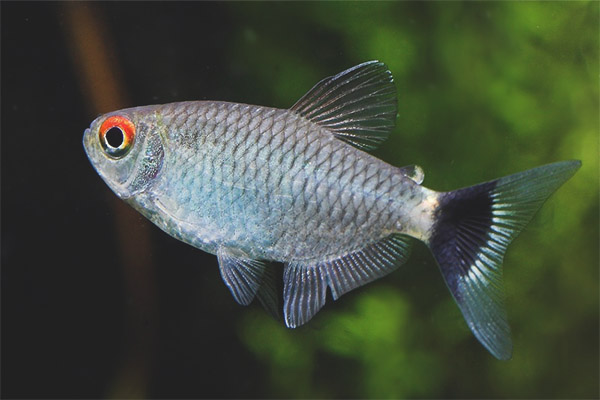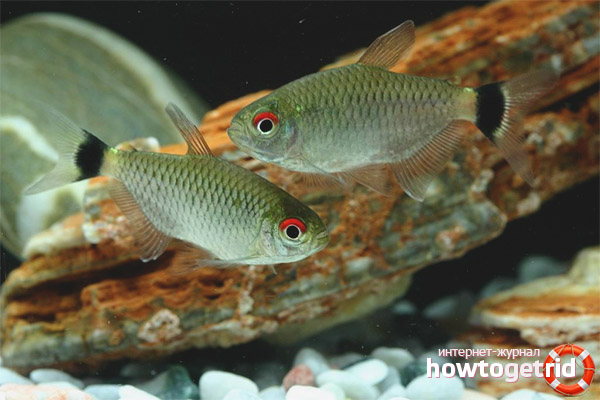The content of the article
The fish filomenu is also called the red-eyed tetra. In Latin, its name sounds like Moenkhausia sanctaefilomenae. Due to their attractive appearance, they have become very popular among aquarists. In the blend of black and silver shades. The highlight of the exterior are red eyes, thanks to which the look got its name.
If you keep a flock of 6 or more of these fish in an aquarium, it will attract attention with its metallic sheen. The red-eyed tetra is a pretty peaceful fish. In the content she is picky. This allows you to keep it together with many species of fish. You can start a filomena even for those who have no experience in maintaining an aquarium.
Habitat
Fish of this species live in South America. A lot of them in Argentina and Brazil. Philomena like clean water, so you can meet them in clean rivers.As a rule, these rivers have dense vegetation. In addition, in these bodies of water there are a lot of surface plants, for example, salvinia and eihornia. From algae echinodorus are common here. Philomena can live in troubled waters.
Food for them are various insects and crustaceans. The filomens that are sold in stores are not caught in nature. In Europe and Asia there are a lot of nurseries in which they are actively bred.
Description
These fish are quite small - about 7 cm. The body has a diamond shape, like other tetras. It is silver in color. The base of the tail is black, on it is a yellow stripe. A red spot is located in the eye area.
With aquarium maintenance, this fish can live for about 5 years.
Content
Since they are accustomed to live in flocks in the wild, it would be advisable to keep at least 5-6 individuals in an aquarium. To ensure they have enough space, you need to purchase an aquarium of at least 55 liters. It is also important to take into account that in the natural habitat of the philomene there are many algae. Therefore, in the aquarium they should be enough. It is desirable that the surface vegetation be present. It will provide shade and bring conditions closer to the natural.
In order for the fish to have enough space for swimming, it is better to place the vegetation closer to the walls of the aquarium. If you decorate the aquarium with various snags, the philomens will feel more comfortable. Sand may be used as a primer, but any will do. The main thing is that it was small and had a dark color. Despite the fact that these fish usually live in clean water, you can create an Amazonian biotope for them in an aquarium. At the bottom there may be leaves, peat pellets, snags. The filter should not create a strong flow.
Water parameters suitable for content filomen:
- The temperature can vary from 22 to 28. But when breeding, it is necessary to maintain 27-29 degrees.
- The pH should be 5.6-8.6.
- Stiffness range 2-30 dGH.
Although these fish are hardy, it is still very important to regularly replace water. The bottom needs to siphon to remove trash. Every week should be replaced from a quarter to half of the water in the aquarium.
Compatibility
Filomeny fit very well into the general aquarium. Thanks to them, it will be much more interesting to watch the aquarium, as they are very active and mobile. The best neighbors for them will be fish, which have similar sizes and the same level of activity. They can be contained with danios, barbs, corridors. Ancistrus and some non-aggressive cichlids are also suitable.
Alone, these fish are better not to contain. This will lead to the fact that they will become nervous and fearful, why they will begin to show aggressiveness towards their neighbors. When kept in flocks, they do not have such aggressiveness.
Feeding
Filomena can eat any food that you give them. But, in order for them to be healthy and retain their attractive color, give preference to frozen and live food (for example, daphnia, bloodworm). You can give them granules and flakes.But in this case it is important to pay attention to the quality of dry food. Sometimes you need to give food, which includes vegetation. In the diet should be vegetables and herbs: spinach, zucchini.
Sex differences
The males of the phylomenes have a thin slender body. While females are more round.
Breeding
Representatives of this species is not so difficult to breed. This can be done both with a group of fish, and with individual pairs. Each female philomena lays 200-300 eggs.
Spawning should have a volume of 55-60 l. It is necessary to pour fresh water into it. It is important that the temperature is maintained at 26.7 - 29 degrees. Stiffness - no more than 4. The pH should be in the range of 5.6-6.4. It is important that the light is dim. At the bottom of the spawning should be laid moss and plants with small leaves. To the fish did not eat their own caviar, it is desirable to put a net on the bottom. To create the effect of a weak flow, an airlift filter is installed.
In one spawning you can run more than one pair of files. Maximum - 6. Before spawning, future parents are fed with high-quality live food. Such nutrition must be provided during the week.Females and males are seated separately.
It is necessary to choose the plumpest females, as well as the males with the brightest colors. In the evening, they are launched into spawning. The next morning will be caviar. Immediately after this, the manufacturers are transplanted. After a day or a little more fry begin to hatch. In a few days they will sail by themselves.
Video: philomen aquarium fish












To send